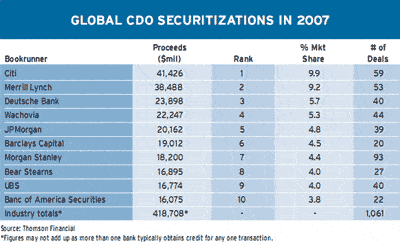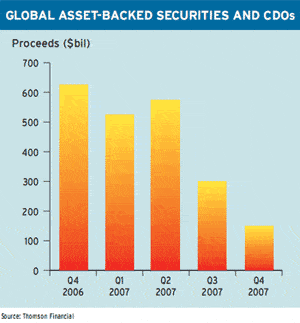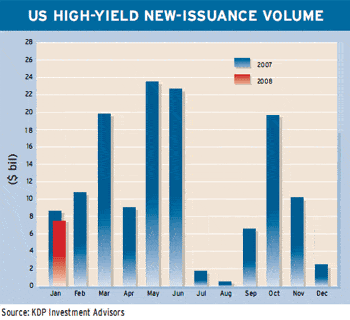 |
“Securitization is an absolutely vital structuring technique,” says Greg Cioffi, partner in New York law firm Seward & Kissel’s corporate finance group. Cioffi has significant experience with a broad range of structured finance transactions. His primary focus is in the area of asset-based securitization, restructurings and reorganizations.
The US subprime meltdown is likely to produce unprecedented levels of events of default and asset liquidation relating to CDOs and structured investment vehicles (SIVs), particularly for portfolios with high concentrations of subprime mortgage-related securities, Cioffi says. For many transactions, it will take time to sort out who gets paid first after a “wind down,” he says.
The priority-of-payment sections of CDO and SIV documents are very complex and usually run to several pages, Cioffi says. Investors need to understand the terms of the underlying documentation to better assess the risk of events of default occurring, as well as the rights and remedies the holders of a particular class of notes will have after an event of default, or an enforcement event, in the case of SIVs, he says.
Most CDOs have “OC tests” that are triggered when the CDO fails to maintain specified minimum levels of over-collateralization, in excess of what is needed to adequately cover the repayment of the securities. The failure of such a test usually only results in a diversion of payments from subordinated noteholders to more senior noteholders. However, certain CDOs include the failure of an OC test itself as an event of default.
If there is a default, the controlling class of noteholders, which is typically the most senior class of noteholders, often has the greatest influence over the disposition of collateral. In distressed market conditions there are situations where it may be advantageous for the controlling class to compel a liquidation of the portfolio despite the potential negative impact on subordinated investors, Cioffi says. The most subordinate class of notes, often referred to as the equity class, is rarely given any right to direct or to consent to a liquidation of the pool of collateral.
 |
As a result of the inherent complexity of the provisions of CDO and SIV documents that govern the priority in which holders of various classes of notes and other creditors are paid, different classes of creditors often take conflicting positions as to the proper interpretation of ambiguous provisions following a wind down. Trustees who are charged with applying such proceeds are in many cases receiving conflicting directions from creditors and are being threatened with lawsuits if the trustees do not comply with their directions. As a result, trustees in two separate transactions have recently filed “interpleaders” in the courts in order to obtain direction as to the proper manner of allocation.
Cioffi says no new legislation or changes in regulation for the securitization market are required because investors will demand the type of product they are comfortable with. For instance, as a result of the subprime crisis, investors will most likely require far greater access to monthly reports relating to the asset portfolios of structured transactions in order to conduct independent credit analysis. In addition, investors will probably require greater transparency as to the methodologies used to determine asset value and the credit quality of assets, Cioffi says.
The industry already is considering initiatives aimed at restoring investor confidence, such as increasing the amount and frequency of the portfolio information given to investors and providing more standardized reporting, according to Cioffi. “These efforts hopefully will go a long way to restoring confidence in structured products,” he says.
Cioffi is currently involved in restructuring CDOs as well as SIVs, which incorporate many of the characteristics of traditional asset-backed vehicles but at the same time have much of the flexibility of operating companies. In contrast to CDOs, the SIVs have no preset investment period and can generally continue to issue senior notes and capital notes and to acquire assets for an indefinite period of time.
SIVs Encounter “Perfect Storm”
SIVs typically purchase highly rated medium- and long-term assets and fund the purchase of these assets through the issuance of highly rated commercial paper and medium-term notes in order to generate a spread between the yield on the SIV’s portfolio and its cost of funds.
SIVs were structured to weather periodic short-term lack of liquidity. However, the subprime meltdown and the resulting lack of access to the commercial paper market for SIVs, coupled with the fact that the portfolios of the SIVs are marked to market on a daily basis, amounted to the “perfect storm,” Cioffi says.
There is flexibility inherent in the SIV structure, due in part to the latitude the manager of an SIV has with respect to the operation of the vehicle, according to Cioffi.
In contrast to CDOs, SIV managers have far more discretion to determine the composition of the assets in the SIV’s portfolio, to dispose of assets and to conduct the SIV’s operations.
Originally introduced in the 1980s, CDOs have been among the fastest-growing investment products in the asset-backed securities market. “With the proliferation of structured finance securities such as CDOs, the means to accurately value them due to a lack of depth in the market led to many valuations being ‘marked to model’ or ‘marked to fantasy,’ as it turned out,” says Damian Shaw-Williams, financial services technology senior analyst at London-based Datamonitor, an independent market analyst.
 |
The subprime crisis was exacerbated by over-reliance on modeling and silo structures that prevented aggregation of risk across companies, according to a report by Datamonitor that was written by Shaw-Williams and was issued on January 31. The ongoing crisis highlights the need for an enterprise-wide approach to risk management, the report says.
“The inability to aggregate an organization’s overall risk position allowed a failing of credit-risk principles in a relatively small section of the US housing market to spill into a wider liquidity risk for global wholesale finance markets,” the report says. It says the silo structure in the majority of organizations resulted in a lack of transparency, which led to a breakdown of confidence, since the exposure of market participants was unknown.
The modeling of exposure to CDOs also failed to address the highly leveraged nature of many funds, leaving many exposed to any downgrades, which could lead to a further sell-off of assets and contribute to a downward price spiral, Shaw-Williams says.
As a result, financial institutions around the world will re-evaluate their enterprise risk strategy and may increase spending on operational-risk-related technology in the search for competitive advantage, the report concludes. Operational risk is the risk of loss resulting from failed internal processes, systems and people, as well as external events.
While financial institutions have always needed to manage operational risks, the practice of ORM (operational risk management) is still evolving. “More than ever, corporate directors, business executives and risk professionals realize that operational risk is critical, not only for regulatory compliance but also for operational efficiency and effectiveness,” Shaw-Williams says.
 |
Meanwhile, as Global Finance went to press, pressure was building on struggling bond insurers that previously had been considered too important to fail. “The fate of the monoline insurers is of paramount importance to financial stocks, as further downgrades of major monoline insurers by the rating agencies could put another $100 billion in assets held by banks in jeopardy of further write-downs,” analyst Meredith Whitney of Oppenheimer wrote in a research note.
“Among the myriad of negatives that surround financial stocks today, we see no issue more critical than the fate of the monoline insurers,” Whitney said. Bond insurers make principal and interest payments when issuers default.
Regulators led by New York insurance superintendent Eric Dinallo were trying to put together a plan last month that would recapitalize the insurers, which are facing big potential losses on guarantees they sold on CDOs.
MBIA, the world’s largest bond insurer, posted a fourth-quarter 2007 loss of $2.3 billion and reported write-downs of $3.5 billion on credit derivatives. The Armonk, New York-based insurer has more than enough capital to keep its AAA credit rating, CEO Gary Dunton said in a conference call.
In a worst-case scenario, were a monoline to lose its AAA ratings and its ability to write new business going forward, the company essentially would go into a runoff mode, according to a report by Seth Glasser, credit research analyst at Barclays Capital in New York. In the insurance sector, “runoff” is rarely synonymous with “default,” he said.
“We have looked at this issue in a number of ways, and in the event this happens, we strongly believe that any of the monolines we cover likely could bleed their way into 2009 and perhaps longer,” Glasser said.
At the operating-company level, companies could carry on for some time meeting policy obligations from their insurance claims-paying resources in an orderly manner, according to Glasser.




